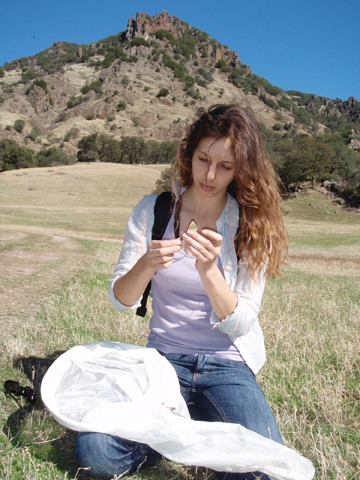
And a free one, at that.
UC Davis graduate student Melissa Whitaker, who is studying for her doctorate with noted butterfly expert Arthur Shapiro, distinguished professor of evolution and ecology at UC Davis, has just created an app or application for iphones, ipods and ipads.
It's called Butterfly Guide: Butterflies of the Sacramento Valley, Delta and San Francisco Bay Area. Click on Itunes to download it.
So if you're from the Sacramento or San Francisco area, and see a butterfly fluttering around, you can identify it by consulting this free app. Western tiger swallowtail? Check. That would be Papilio rutulus. Monarch butterfly? Check. Danaus plexippus. Gulf fritillary? Check. Agraulis vanillae.
Her app includes 117 species of butterflies, complete with photos, descriptions, common names, scientific names and family names. Shapiro, her key source of information and inspiration, maintains a comprehensive website that includes data he's collected for more than three decades. He's the author of Field Guide to Butterflies of the San Francisco Bay and Sacramento Valley Regions.
Whitaker engaged two computer science undergraduates, Joey Jiron and Bryan Maass, for the app development.
Whitaker, who's from Colorado but claims California as home, says she's relatively new to the butterfly scene. "Always a lover of nature and natural history education, I quickly arrived at butterflies as ideal study organisms for my PhD research," she says.
Whitaker describes the app as a "mobile tool for natural history education and biodiversity informatics, using the butterflies of the region."
Her website details how to use the guide and how to share data. She's hoping to encourage users to become citizen scientists.
Whitaker is especially interested in the teaching aspect. "Butterflies are absolutely terrific models for education in the science classroom, and capture the attention of all ages," she says on her website. "They can be used to teach many biological concepts: mimicry, conservation, species interactions, biodiversity, migration, ecology, evolution, life history development, and on and on! They can also be great tools for inspiring people to spend more time outside observing their natural (or semi-natural) surroundings. With this in mind, we hope teachers and educators will find ways to incorporate butterfly monitoring into their classrooms and will share their curriculum and ideas. For great ideas for biodiversity lesson plans check out Project Noah's Education page."
"Our long-term vision for this project is that The Butterfly Guide will provide a template for The Lizard Guide, The Urban Spider Guide, The Wildflower Guide—a whole series of guides!" she says. "With that in mind we can provide all development materials to folks who want to create their own educational, community-driven and non-commercial (free!) field guide apps."
The National Science Foundation funded the project through its REACH-IGERT program. REACH is an acronym for REsponding to RApid Environmental CHange (REACH), while IGERT is Integrative Graduate Education and Research Traineeship.
Attached Images:
